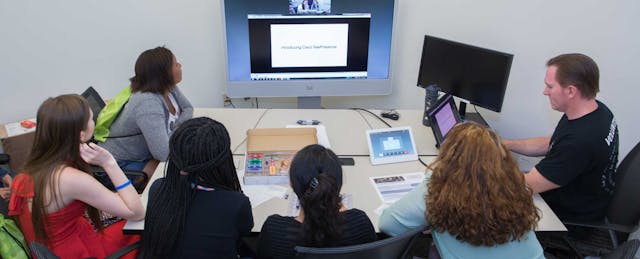During the week of April 20th, more than five hundred students gathered at the Cisco Systems campus in Research Triangle Park to participate in the first-ever STEM Mentoring Week, an event originally announced at the 2015 White House Science Fair in partnership with US2020.
One student, Carlos, had never met an engineer. When asked, he wasn’t quite sure what engineers do. “Make video games?” he guessed.
Students from low-income families—as well as girls and underrepresented ethnic minorities—face myriad barriers to success in science, technology, engineering and math. The country’s STEM workforce remains three-quarters male and overwhelmingly (85%) white and Asian. As has been often noted, addressing this diversity gap is not only a social justice issue, but an economic imperative.
At the White House Science Fair in March, US2020 announced a major commitment by Cisco to mobilize 20% of its workforce to engage in STEM mentoring, starting with a company-wide STEM Mentoring Week. The initiative was an effort to meaningfully connect students like Carlos to professionals in science, technology, engineering and math. By the end of the week, more than 600 Cisco employees mentored over 500 middle and high school students in Durham and Wake Counties.
Quality STEM mentorship is uniquely positioned to address the primary barriers to pursuing STEM careers: lack of exposure to STEM and lack of connections to STEM professionals. Research has shown that having adult role models provides academic and emotional benefits for students, particularly at-risk youth.
But to realize these benefits, mentorship must be done well. Here are five keys lessons that came out of the STEM Mentoring Week experience:
1. High-quality mentorship is experiential
Building a rocket or solar car, writing code, and programming robots allows students to experience the real-world application of STEM. At Cisco, students collaborated to build working motors out of Snap Circuits. These experiences can ignite “moments of discovery” where students connect STEM to their futures. Research shows that students interested in STEM are more likely to have participated in hands-on STEM activities.
2. High-quality mentorship is measurable
It’s difficult to draw a causal link between a mentee’s experience and her later educational and career choices. But there are meaningful insights that companies and nonprofit organizations can derive from feedback surveys. At Cisco, we saw dramatic increases in the number of students interested in pursuing careers in STEM (80.3% of students in the post-survey said that they’re “somewhat interested” or “very interested” in a job in STEM). Gains in student interest in STEM subjects have been shown to persist long after hands-on activity participation has ended.
3. High-quality mentorship is sustained
STEM Mentoring Week helped students build awareness and excitement for STEM careers and served as a “stepping stone” for Cisco employees to become involved in longer-term STEM mentoring. The initiative helped build a pipeline of more than 600 volunteers, two-thirds of whom had never mentored before. Ideally, STEM mentors meet with students over a number of weeks or months, developing relationships with their mentees and serving as role models. The positive benefits of a mentoring relationship grow the longer the relationship is sustained.
4. High-quality mentorship focuses on underrepresented students
Cisco and US2020 recruited neighboring middle schools that had significant numbers of students on a free or reduced-price lunch program. Low-income children have less access to extended learning opportunities and lower achievement in STEM subjects. Black and Hispanic girls are much less likely to know someone in a STEM career, have had less exposure to STEM, and receive less adult support for pursuing STEM fields.
5. High-quality STEM mentorship is led by STEM professionals
STEM Mentoring Week mobilized one of Raleigh-Durham’s largest concentrations of STEM professionals. Multi-session engagements with STEM professionals allow students to envision pathways for themselves to pursue STEM careers. Studies have shown that students engaged with STEM professionals have more confidence in their STEM capabilities and more knowledge of STEM careers.
By 2022, the U.S. will need more than nine million STEM professionals to fill projected job openings. But of all bachelor’s degrees earned today, only 18% are in STEM fields. The U.S. News/Raytheon STEM Index—which tracks key indicators of STEM-related activities in the U.S.—shows that since 2000, student interest and competency in STEM subjects have remained flat.
To get more low-income students engaged in science, technology, engineering and math, we must find mentorship opportunities in our own communities and invest in programs that connect low-income and underrepresented students with professionals in STEM. And if those programs don’t already exist at our companies, then we must create them.
Know a great mentor or STEM program? US2020 is accepting nominations for the STEM Mentoring Awards, which will be held at the White House Complex on Thursday, July 23rd. More information about the US2020 network can be found at www.US2020.org.


